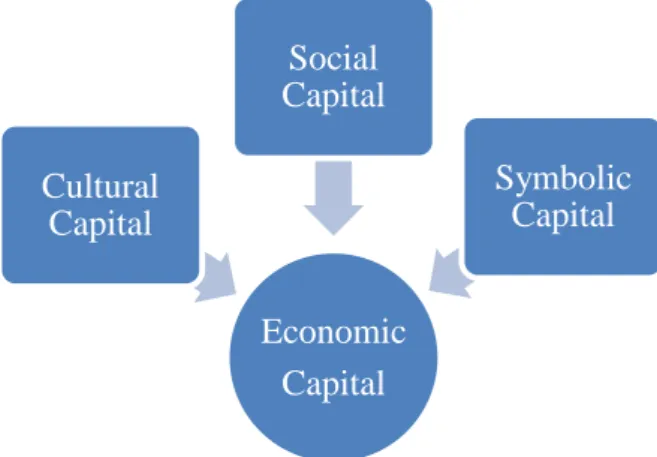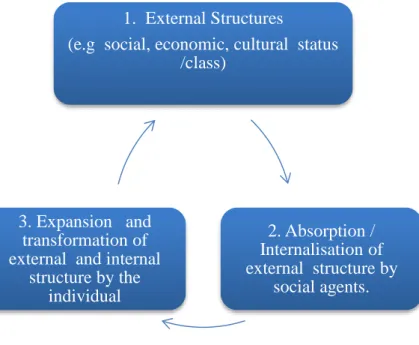Their words are rewritten, but the general information attributed to them is referenced. Where their exact words have been used, their writing has been put in italics and within quotation marks and referenced. Without her constant support and encouragement, the completion of this paper and study would not have been possible.
BACKGROUND AND PROBLEM STATEMENT……………………………………….………………..1-10
Research questions
Research objectives
KEY CONCEPTS
- Plagiarism…………………………………………………………………………..………………………12-13
- Academic dishonesty
- Copyright infringement
- Context…………………………………………………………………………..……………………..……14-15
- Culture, academic culture and cultural capital …………………..…………………..…….……….…15-19
The students borrow text to meet the norms and standards of academic writing. Culture is transmitted to the students by their families through active and passive efforts (Anderson and Jaeger, 2015). The type of culture that Bourdieu refers to above as being passed on to the students by their families is cultural capital.
INTRODUCTION
The students will therefore deal with plagiarism based on their knowledge and experiences of plagiarism (East, 2006). The institutionally valued type of information is normally reduced to the students' natural talent (Bourdieu, 1993). Moreover, the more the students become "technologically savvy" (good at using computers), the more difficult it is to tell whether they have plagiarized from the Internet or not (Ercegovac and Richardson, 2004:309).
Students are left to read these institutional policies and procedural documents on plagiarism (Howard, 2001). Horn (2013) in particular, asserts that academic staff practices have an impact on students' academic practices. Early experiences can refer to (but are not limited to) students' experiences in high school where they are first introduced to academic content.
Plagiarism can be a condition facilitated by the ignorance of the students, as opposed to an intentional act. Students' ambitions, aspirations and motives for studying play a major role in the accumulation of cultural capital (Dumais and Ward, 2010:87). According to Smith, the interaction between the students' habitus and the institutional habitus constructs a kind of 'culture of practice'.
Family background (or habitus) influences the students' educational choices, attitudes, values, interests and preferences (Barker and Hoskins, 2015:1). For example what the students' words, actions and experiences mean in relation to the context (Terre Blanche et al. In this study the students' perceptions, understandings and experiences (through the analysis of attitudes, feelings and behaviour) of plagiarism were analyzed in relation with academic study practices in the university.

DATA COLLECTION AND ANALYSIS
Data collection…………………………………………………………………………………………..112-113
The main aim of the study was to find out the attitudes, feelings and experiences of plagiarism among students. Therefore, capturing the students' attitudes and opinions towards the topic of plagiarism was crucial in the transcription process. During the data collection process, the names and details of the students (their age, gender, year of study and the courses they attended) were recorded.
The students stated that one punishment for those found guilty of plagiarism was academic expulsion. A majority of the graduate honors students said yes, plagiarism would decrease if the students worked primarily from hard copy sources. According to the data collected, the students were not aware of the different types of reference methods.
So students would plagiarize regardless of whether they knew about the plagiarism or not. Students understood certain aspects related to plagiarism rather than understanding plagiarism in its entirety. None of the students recognized or even acknowledged the various multifaceted nature of plagiarism.
According to the findings, student awareness of university policies and procedures was markedly lacking. In addition, academic staff and lecturers play an important role in students' learning and writing processes. Universities should ensure that students (both undergraduate and postgraduate) are proactively and effectively made aware of the issue of plagiarism.
ENSURING TRUSTWORTHINESS IN THE REASEARCH STUDY
SUMMARY
This chapter has defined and explained all the methods and processes that were used during the collection and analysis of data in the study. The methods and methodologies used in this chapter were chosen to obtain in-depth data on student plagiarism. The researcher used various qualitative methods and data collection instruments to present accurate accounts of students' perceptions, understandings, and experiences of plagiarism.
The main results obtained using techniques highlighted in this chapter are discussed in depth in the next chapters which are Chapter 5, the main findings chapter and Chapter 6, the discussion chapter.
INTRODUCTION
STUDENTS’ UNDERSTANDING OF PLAGIARISM AND ITS SIGNIFICANCE IN ACADEMIC
First year student views on the academic significance of plagiarism……………………………119-120
120 P7: “ Yahh...this is important only because...to avoid or make students aware that what actually...is what lecturers are looking for for them is to see if they can the information in their own words place or like to show their ability. P12: “I think that here, we hate to learn right… we hate to learn, so when a person takes another person's work, they don't get anything, so if you get points for another person's work, let's say you become like a 100% you know, how about me who did my job...and then it's not fair. I did my work, I studied, I did my research, I get lower marks than you... it's not fair.
P1: “I can say, being in the media, it's very important to know about plagiarism, err...yeah, to be aware that it's illegal to take someone's idea and write it as your own...yeah. P6: “ Err ... this is important because some people, err ... now have degrees, some have PhDs, some have. P1: "It will help them to be good researchers in the future and so on."
P3: “Uhm… I think it's important because err… it takes someone who has an honor or a degree to come up with new ideas in that particular field, maybe if that's the case, let me give you an example. .. for example if you're doing like chemistry, there might be other ideas you have that aren't in this book or those people didn't find it, so if you plagiarize and put someone repeating the same kari over and over again, don't create something new that someone else is going to use because that means in a way it's killing the education system because there's information that you won't get in the future because people will repeat the same thing but pretend it's theirs , but if... if maybe you're not a plagiarist you'll dig deeper and think of new ideas that will come from your own words, not someone else's work.” In conclusion, both first-year undergraduate students and postgraduate honors students demonstrated an understanding of the importance of plagiarism in academic scholarship. Graduate students, however, gave more detailed and consistent answers compared to first-year students.
For example, 4 out of 12 of the first-year students, as mentioned earlier, were unaware of why plagiarism was significant in academic science.
Student exposure to plagiarism prior to entering university………………………………………121-123
A total of 18 out of 23 first-year and graduate students felt that incorporating university strategies to curb high school plagiarism would be beneficial to students. Based on the findings, most students are aware that references are an essential part of the academic work. The most important thing in the graduate students' responses was that students learned how to use the resources over time.
When students were asked whether they felt the Internet encouraged plagiarism or not, seven out of twelve freshmen said they felt the Internet encouraged plagiarism. When the students were asked if they thought working with primarily paper sources would reduce the incidence of plagiarism, the first-year students were split in half. Six first-year students said yes, plagiarism would decrease if students worked primarily with paper sources, while the other six said no.
Turnitin is used at the University of KwaZulu-Natal as a tool to detect cases of plagiarism in student work. Furthermore, the data collected did not convincingly demonstrate whether the students' backgrounds played a role in their learning processes. It is not until students reach college that they learn acceptable writing practices.
Overall, there was no evidence that the Internet would lead to more plagiarism among students. Students' motivations and values play an important role in their interactions with the academic field (Nash, 1999). However, the majority of students were unable to describe and elaborate on the content of the policy and procedure documents.
RECOMMENDATIONS
- Early familiarisation and demystification of university practices for high school students
- Academic staff and lecturer training workshops………………………………………………..….180-181
- Anti-plagiarism software
- Raising awareness on plagiarism………………………………………………………………….…182-183
Lecturers and academic staff can benefit from their roles by proactively disseminating and deconstructing for students appropriate academic writing procedures. Academic staff should explain to students the importance of referencing and how to do it appropriately. In addition, before educating students about plagiarism, tutors, lecturers and other academic staff can assess students' knowledge and understanding of the term.
Lecturers and academic staff would specifically target problem areas of students where they express confusion about what is appropriate. Peer review structures and activities could be developed and promoted within institutions as strategies to help students deal with plagiarism. Group activities would take less time for assessment than individual student work.
Although the anti-plagiarism software did not seem to have a significant impact on students' writing and learning processes. Most of the students in the study appeared to be unaware of the institutional policies and procedures that the institution uses to deal with plagiarism. Before developing tactics for disseminating plagiarism policy and procedure documents, institutions must ensure that the policies are compatible with the students enrolled in them.
In addition, institutions should try to foster a culture of honesty by encouraging open dialogues with students about the issue of plagiarism.
RECOMMENDATIONS FOR FURTHER RESEARCH
How socioeconomic and sociocultural backgrounds mediate in the students learning and writing
It is not enough for institutions to claim to have plagiarism policies and procedures, but these policies must be enforceable. Having structures in place that can be held accountable for dealing exclusively with the expressions of plagiarism would ensure that plagiarism issues are dealt with adequately and appropriately.
Research methods
Discourse acquisition, the construction of identities, and the complex issue of plagiarism: ESL students writing in graduate school. International students and plagiarism: an analysis of the reasons for plagiarism among international foundation students. British Journal of Sociology of Education, p. 2005). Understanding the context before using it. InModeling and using context (pp.
APPENDIX A: INTERVIEW SCHEDULE FOR FIRST YEAR STUDENTS
APPENDIX B: INTERVIEW SCHEDULE FOR POSTGRADUATE HONOURS
